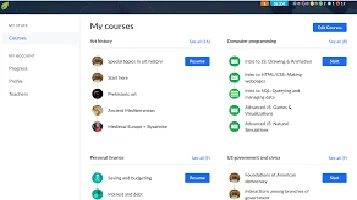Khan Academy: A Detailed Review of a Leading Online Learning Platform
Khan Academy is a renowned online learning platform dedicated to providing free, high-quality educational resources to learners worldwide. Founded by Salman Khan in 2008, the non-profit organization offers a comprehensive library of instructional videos, practice exercises, and personalized learning dashboards across a wide array of subjects including mathematics, science, economics, and humanities. The platform caters to students, teachers, and lifelong learners, offering content from kindergarten through early college, as well as test preparation for standardized exams like the SAT and MCAT. Khan Academy's user-friendly interface and adaptive technology enable learners to progress at their own pace, making education accessible and engaging. With a mission to empower and inspire, Khan Academy continues to transform how knowledge is acquired and shared globally.

In the ever-evolving landscape of education, online learning platforms have become indispensable tools. Among these, Khan Academy stands out as a beacon of accessible, high-quality education for students, educators, and lifelong learners worldwide. Founded in 2008 by Salman Khan, this non-profit organization aims to provide a free, world-class education for anyone, anywhere. In this review, we will delve into various aspects of Khan Academy, evaluating its content quality, user experience, accessibility, and overall impact.
Content Quality
One of Khan Academy’s most commendable features is its extensive and diverse content library. The platform covers a wide range of subjects, including mathematics, science, economics, history, and even arts and humanities. Each subject is broken down into comprehensive, digestible modules, making complex topics accessible to learners at different levels.
The instructional videos are succinct, clear, and engaging. Salman Khan’s distinctive style of using a virtual blackboard to illustrate concepts has proven effective in simplifying difficult subjects. The lessons are well-structured, often starting with basic concepts before progressing to more advanced topics. This scaffolded approach helps in building a strong foundation, which is crucial for subjects like mathematics and science.
Moreover, the platform regularly updates its content to align with current educational standards and curricula. This ensures that learners are receiving relevant and accurate information. The inclusion of practice exercises, quizzes, and unit tests further reinforces learning, allowing students to apply what they have learned and track their progress.
User Experience
Khan Academy’s user interface is intuitive and user-friendly, catering to a wide range of users, from young children to adults. The website is well-organized, with a clear structure that makes navigation effortless. Users can easily find courses, track their progress, and access supplementary resources.
The platform also offers personalized learning dashboards that provide tailored recommendations based on the user’s performance and learning history. This adaptive learning technology helps identify areas where the learner may need additional practice, thereby creating a more personalized and effective learning experience.
Furthermore, Khan Academy has incorporated gamification elements, such as badges and energy points, to motivate learners. These features add an element of fun and competition, which can be particularly engaging for younger users.
Accessibility
Khan Academy’s commitment to accessibility is evident in its efforts to make education available to as many people as possible. The platform is completely free, removing financial barriers that often hinder access to quality education. This democratization of learning is one of Khan Academy’s most profound impacts.
In addition to being free, Khan Academy is available in multiple languages, broadening its reach to non-English-speaking learners. The platform also offers a mobile app, ensuring that users can access educational content on the go, regardless of their location. This flexibility is particularly beneficial for students in remote or underserved areas who may not have consistent access to traditional educational resources.
Furthermore, Khan Academy is inclusive of learners with disabilities. The videos come with subtitles, and there are options to adjust the playback speed, catering to different learning paces and needs. These features underline Khan Academy’s dedication to creating an inclusive learning environment.
Impact and Community
Khan Academy’s impact on the educational landscape is significant. The platform boasts millions of users worldwide, including students, teachers, and parents. It serves as a supplementary resource for traditional classroom learning, providing additional support and enrichment for students.
Teachers, in particular, find Khan Academy to be a valuable tool. The platform offers resources and tools specifically designed for educators, allowing them to track students’ progress, assign tasks, and identify areas where students may require extra help. This integration of technology in the classroom enhances teaching efficiency and effectiveness.
Moreover, Khan Academy fosters a sense of community among its users. The discussion forums and comment sections enable learners to engage with each other, ask questions, and share knowledge. This collaborative learning environment enhances the overall educational experience, making it more interactive and dynamic.
Areas for Improvement
While Khan Academy excels in many areas, there is always room for improvement. One potential area for enhancement is the depth of content in certain subjects. While the platform covers a broad range of topics, some advanced or niche subjects may not be as thoroughly represented. Expanding the content library to include more specialized courses could further benefit advanced learners or those with specific interests.
Additionally, while the user interface is generally intuitive, there could be more customization options for learners and educators. Allowing users to personalize their learning environment further could enhance engagement and satisfaction.
Conclusion
In conclusion, Khan Academy is a stellar example of how technology can revolutionize education. Its high-quality content, user-friendly interface, and commitment to accessibility make it a valuable resource for learners worldwide. While there is always room for growth and expansion, the platform’s positive impact on education is undeniable. By providing free, world-class education to anyone, anywhere, Khan Academy is not just a learning platform; it is a catalyst for global educational equity.






